Kicking back at the regime: artists open another front in Myanmar war

With the military increasing its use of informants, rappers and artists must keep their identities secret, even from one another
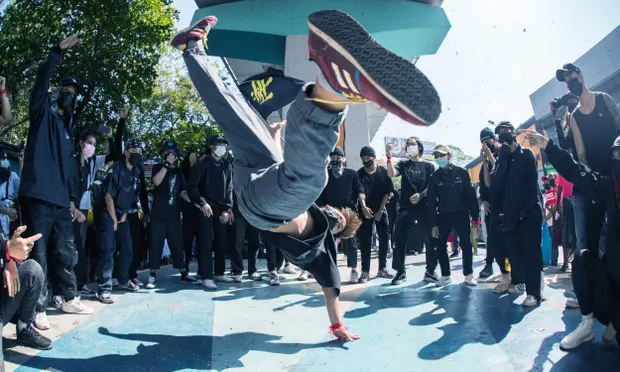
Hip-hop dancers protest in Yangon, February 2021. Composite: Kenji
By The Guardian
Early one morning last February, a group of young people gathered on a street corner in Myanmar armed with brushes and buckets of paint. In the faint light of dawn, they quickly completed their task and dispersed.
“I felt excited and nervous. I was scared too, because I didn’t want to get caught,” says Tu Tu, a pseudonym for the group’s organiser.
Hours later, the streets were teeming with people demanding that the military, which had seized power on 1 February, stand down. Media reports from that day show people marching and drone photographs of huge resistance slogans painted on the road. Tu Tu’s group had succeeded in its mission.
“I believe that everyone should be involved in this revolution, but holding guns is not enough. We can only win this by participating in every way Black Art
It was one of many ways that the arts have invigorated the pro-democracy movement. During the first weeks after the coup, as protest chants and revolutionary songs reverberated across the country, artists energised the crowds with dance and music, and covered walls and streets with murals and graffiti.
Within weeks, however, the sound of gunfire and the screams of protesters filled the air while blood stained the streets. One year on, the military has killed about 1,500 people and arrested more than 11,000 – 8,700 of whom remain behind bars.
These violent crackdowns have made it too dangerous to make art in public. But some artists continue to work underground.
“Art is as powerful as a weapon,” says Tu Tu. “When we fire a gun, one bullet can only hit one enemy, but if we can illustrate something clearly through art … we can spread our message much faster.”
Q&A
What is the Reporting Myanmar series?
In February 2021, Myanmar’s progress towards democracy was brutally stalled when the military seized power and took control of the country.
In the year since, the country has been plunged into violence, poverty and mass displacement as the military attempts to crush widespread resistance to its rule.
Internet blackouts, arbitrary arrests, a ruthless curtailing of freedom of speech and escalating military attacks on civilian areas have silenced the voices of people from Myanmar.
For this special series, the Guardian’s Rights and freedom project has partnered with a diverse group of journalists from Myanmar, many working in secret, to bring their reporting on life under military rule to a global audience.
Journalists in Myanmar are working in dangerous and difficult circumstances, as the military government attacks the free press and shuts down local media outlets. Many reporters still inside the country fear arrest, with others forced to leave their homes and go into hiding in areas increasingly under attack from military forces.
All the reporting in this series will be carried out by journalists from Myanmar, with support from the editors on the Rights and freedom project.
These are the stories that journalists from Myanmar want to tell about what is happening to their country at this critical moment.
After protesting became a life-threatening endeavour, few of Tu Tu’s friends were willing to keep painting words on the ground. They went out a few more times, but finally had to stop. “My friends were worried, so they didn’t participate any more. I understood, but I wanted to do so many things,” says Tu Tu, who requested the Guardian use pseudonyms for them and anonymise their gender and location.
Determined to keep resisting, Tu Tu began making illustrations instead, and took on the artist’s name Black Art. “I don’t need much to make illustrations; I can even do it with just a pen or pencil. I can express anything based on my ideas,” they say.
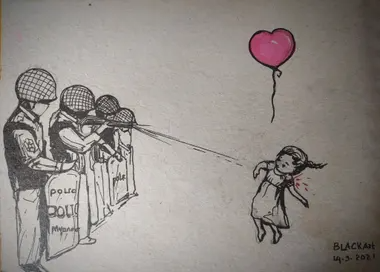
Broken Heart 2 by Black Art. Photograph: Black Art
They have since made dozens of illustrations highlighting the crisis in Myanmar. Broken Heart shows a girl holding a pink balloon and facing a row of police; in a second image, a police officer guns her down and her balloon floats into the air. Coup Makes Orphan shows a child crying in front of a soldier shooting a protester in the head.
Black Art also makes illustrations based on photographs taken across the country. The Last Kiss shows a boy at his father’s funeral, while Screaming from Myanmar has a crying girl clutching her dead father’s photograph. Spring Revolution and The Last Bow depict parents grieving over their children.
Two illustrations, Heroes Never Die and They are Free Now, are tributes to five youths who jumped from the roof of a building in August to avoid being arrested by military forces; two of them died.
“I even cried when I drew some illustrations,” says Black Art. “My illustrations are based on real stories and they are sad stories.”
Since May, armed resistance has grown across the country and the military has responded with indiscriminate attacks on civilians. Black Art’s more recent illustrations highlight the military’s use of airstrikes and arson attacks on towns and villages.
The artist told the Guardian that they see art as a way to document what is happening in Myanmar. “I want art to be left as a form of history which can be seen by the next generation, to prevent something like this from happening again,” they say.
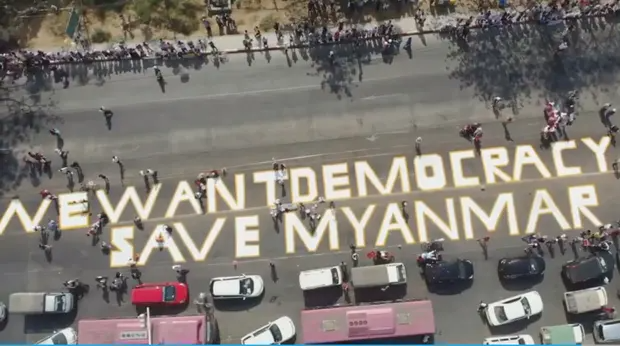
We Want Democracy mural on a Yangon street.
Although many of their friends have decided to take up arms against the military, Black Art remains committed to fighting through art. “I believe that everyone should be involved in this revolution, but holding guns is not enough,” they say. “We can only win this by participating in every way, and I am participating in mine with the belief that we will win.”
Aye Win, a hip-hop artist in Yangon, uses music to rebel. During the protests in February, he and a group of friends held two freestyle rap events under the name Rap Against Junta before they had to go underground. “When [the military] started the crackdowns, we couldn’t meet any more,” says Aye Win. “We all moved to the internet and used different applications to connect.”
In the following months, some of Aye Win’s friends joined the armed resistance against the coup, and others left the country, but Aye Win took on the role of Rap Against Junta’s director and persevered as an artist.
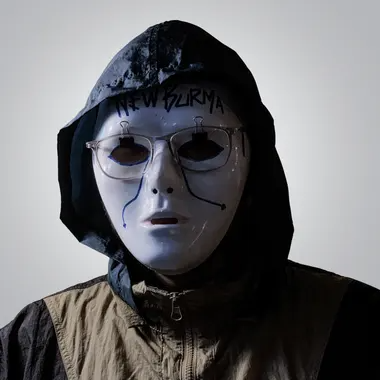
Aye Win, of Rap Against Junta, only allows himself to be photographed behind a mask or interviewed using voice-distorting technology. Photograph: Kenji
On 30 June, the group released Dictator Must Die, a track featuring artists from Thailand, Indonesia, Hong Kong, India, Taiwan and Myanmar. After that, they released a full album on 21 October. Called Dick Council – a play on Sitt Council, the Burmese name for the junta – it included 12 tracks by local artists. It was followed by Blood on 7 January, which features singers from eight different ethnic backgrounds rapping in their own languages.
Throughout this entire process, Rap Against Junta has not held a single in-person meeting. With the military increasing its use of informants to break down the resistance movement, many of the contributing artists have kept their identities secret even from one another.
“Most of the other rappers don’t know who I am and I also don’t know who they are,” says Aye Win, who connected with contributing artists through an open submission process on social media.
The need to maintain anonymity, however, has made it difficult to identify people to support the project. “When we approach people for help using a fake identity, they don’t really trust us and they always put aside the proposals to collaborate,” he says.
Rap Against Junta also had to adapt creatively when promoting their music. In their music videos, their faces are masked or shown in silhouette, while Aye Win has only allowed himself to be photographed behind a full mask or interviewed using voice-distorting technology.
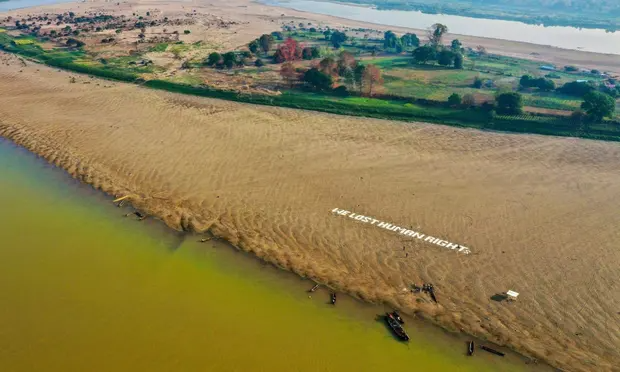
Protesters write ‘We lost human rights’ in sand, February 2021. Photograph: Supplied
As the country’s economic crisis worsens, Aye Win also says it is becoming harder to find people who can give time to Rap Against Junta because they need to earn an income. “People are trying to make money and put food on the table, so they cannot commit like before,” he says.
Aye Win is also facing pressure from his family. “My parents are discussing my future plans. I have just been stuck [at home] and doing nothing for one year. I am doing something, but it is not an established way of making a living for them,” he says. “[They said] I should go somewhere else and survive while I am still young; the future is nowhere to be found here for me.”
But Aye Win sees making protest art as a serious mission. “It is a kind of revolutionary work, and we need to finish by deadlines – we have to pay attention to every detail,” he says.
“We have a lot of very raw protest art here, but we have to maintain our course and go on consistently, without letting up.”
- Emily Fishbein is a freelance journalist writing on human rights and social justice in Myanmar. She focuses on underreported stories using a collaborative approach with local journalists
Additional reporting by Zau Myet Awng
Original Post: The Guardian

